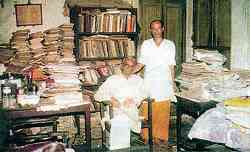|
| ||||||||||||
|
| ||||||||||||
|
|
||||||||||||||||||||||||||||||||||||||
| Home | Roots | Creative Forum | Future Vision | Stop'n Look! | Contact Us | Return to Top | |||||||||||||||||||||||||||||||||||||||
| 1. Extracts from 'Professor Calculus'; article on Professor M C Chaki ;appearing in 'Midweek' of The Statesman, dated Wednesday, October 28, 1998; page 4. |
 |
| Room No 21, Hotel Savoy,
27 Sashibhusan Dey Street, Calcutta. This has been the permanent address
of the seniormost mathematician of india for the past 52 years. Numerous
boarders have come and gone, the hotel itself has witnessed a change of
ownership, yet for Professor M C Chaki, Room No. 21 has been home in the
city.
Walking down from Bowbazaar, you might take a while to locate the hotel. A small doorway leading to a narrow corridor brings one to the reception. A flight of stairs leads up to Room No 21. Open the door and you'll see, breathe and feel mathematics. There's not a nook or corner which isn't stacked with books. In fact, they are even piled on the bed. At night, the bedcover is removed along with the books and placed elsewhere. In the morning, the books are heaped back again on the the bed. Born in 1913, the 86 year old mathematician is a living example of how a student can be influenced by his mentor in developing a love for mathematics. In his childhood, Prof Chaki was not fond of mathematics. He was drawn to literature, painting, music and other fine arts. "Maths class was very boring," he says. It was in Class IX that he began to appreciate the beauty of the subject. He still fondly remembers his teacher, Durgadas Banerjee, at Gaibanda High School, now in Bangladesh. After passing Interscience from Bangabasi College, Chaki chose mathematics and Sanskrit as an undergraduate. Sanskrit is still his second favourite. After completing his MA in Pure Mathematics, he taught for five or six years at Bogra College in Bangladesh, Subsequently, he settled in Calcutta and taught at Bangabasi College. From 1952 onwards, he joined the Department of Pure Mathematics, Calcutta University. He retired as Sir Asutosh Birth Centenary Professor of Higher Mathematics in 1978. But Prof Chaki's career did not end with his retirement. Even at the age of 86, he supervises the work of six research scholars. His papers on "non-symmetric harmonic space", conformally symmetric spaces" and "pseudo symmetric manifolds" have been much appreciated by the Polish and Japanese schools of differential geometry. Incidentally, his contribution in the field of general relativity, especially the concept of "Chaki (PS)" or "Chaki manifold" has given tremendous impetus to research scholars in USA, UK, Canada, Russia, Belgium, Hungary and Yugoslavia. The Tensor Society of Japan has chosen him as the President of their international conference to be held later this year. Though his works have found international acclaim, Prof Chaki has never felt the urge to go abroad, even when he was selected Fellow of the Royal Astronomical Society of London in 1957 and is involved in the review and editing of many international journals. On several occasions, he has learnt languages either with the assistance of his friends or even independently, so as to continue with his research work. He is very conversant in German, French, Italian, Russian and Persian, has a prodigious memory and has never carried any notes to class. This "photographic memory" is also an index of his interest in the welfare of his students. He has devoted his entire life to encouraging and nurturing their potential and they in turn have relentlessly tried to fulfill his dream of establishing an institute. The inauguration of the MC Chaki Institute of Mathematics and Mathematical Sciences was a first in many ways. Prof Chaki had the privilege of witnessing the founding of an institute after his own name. Aided by his 50-year-old faithful attendant, Prof Chaki endeavors to widen the scope of mathematical research from his quaint haunt. What follows are extracts of an interview: Q. In your opinion, how
can one develop an interest in mathematics?
Q. A logical approach
is fundamental for students of mathematics. Do you agree?
Q. Could you be more specific on the use of figures?
Q. Are you satisfied with the manner in which mathematics is taught nowadays?
Teaching geometry in class, teachers often use faulty definitions based simply on figures. While defining the inside point of a circle, teachers often take the help of figures. But visual validity is not always logical validity. The best approach would be to say that if the distance of the point from the center is smaller than the radius of the circle, then the point is located inside it. Teachers should be careful with definitions and precisely enunciate [them]. Q. Have you thought of
offering suggestions on revamping the study of mathematics?
Q. A thesis on the science
of teaching mathematics is quite unconventional ...
Q. What is your opinion
of the maths syllabus at the undergraduate and postgraduate level?
Q. A word of advice for students?
Q. What's mathematics today?
|
| DISCUSSIONS:
Comment # 1: Received from |
| Home | Roots | Creative Forum | Future Vision | Stop'n Look! | Contact Us | Return to Top |
| If you
find our presentations not up to your expectations, or if you do not see
the article/contribution(s) which may have been archived due to paucity
of disc space, please contact us/use the feedback form, or mailto:sankalpatrust@hotmail.com
We shall succeed only with your active participation in these processes. Please send in your comments about our presentations, and your own contributions for inclusion in this page. Meanwhile ... |
© 2000 Sankalpa Trust